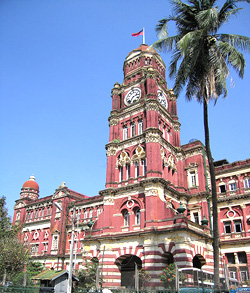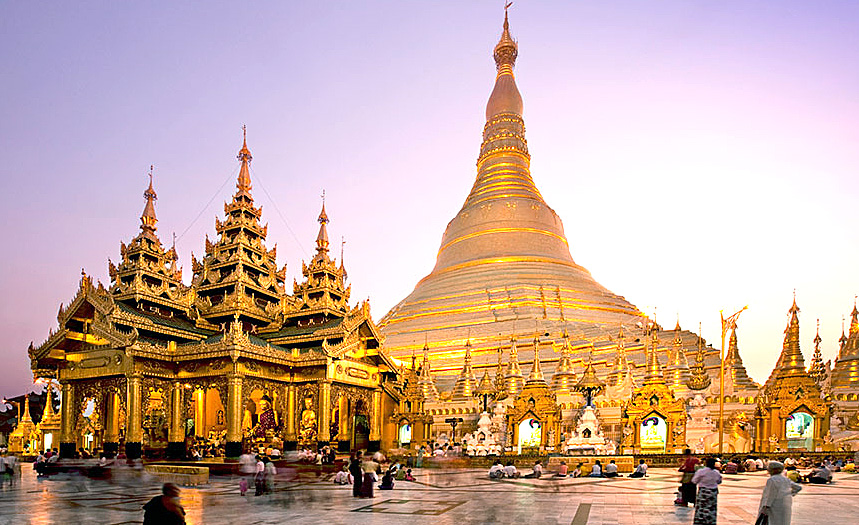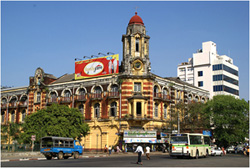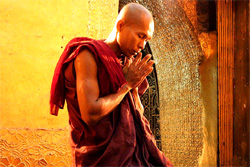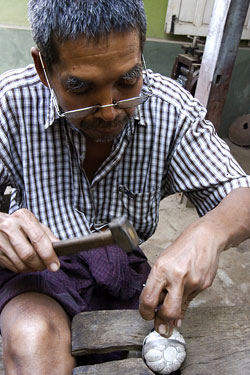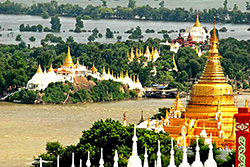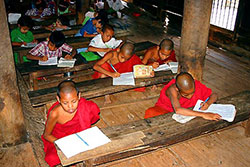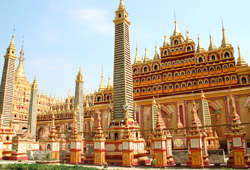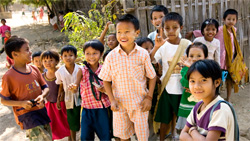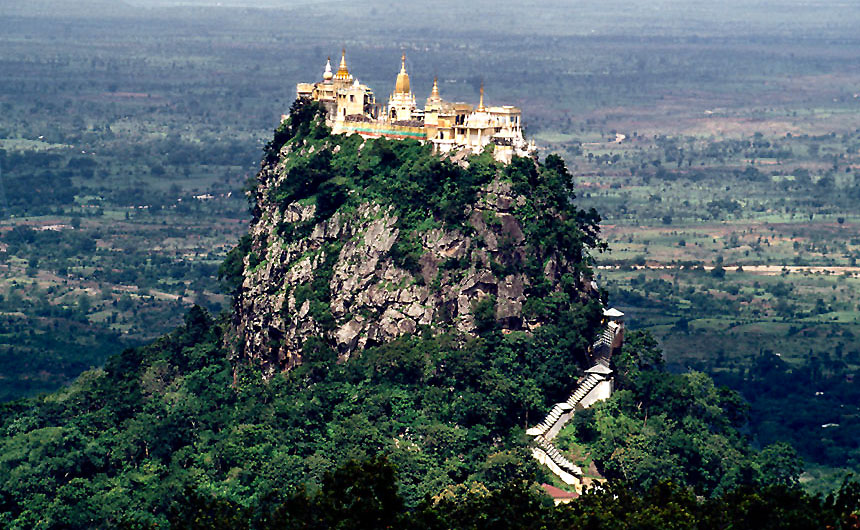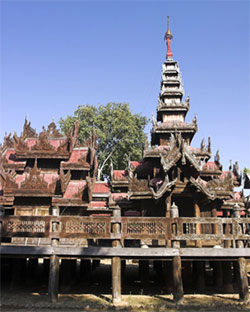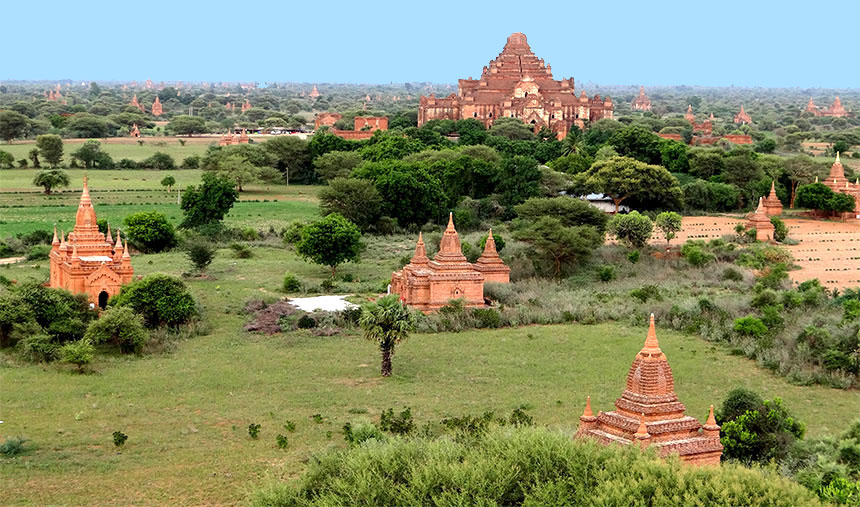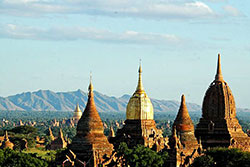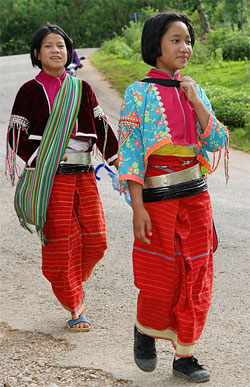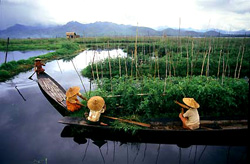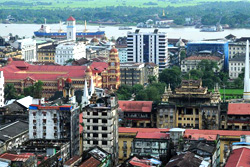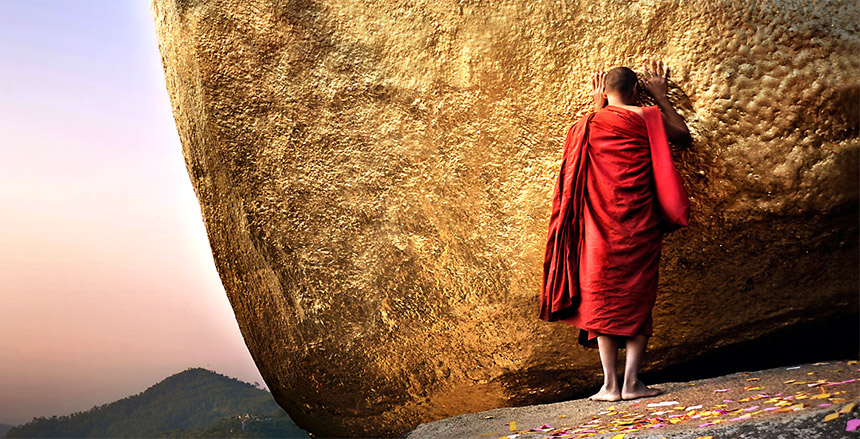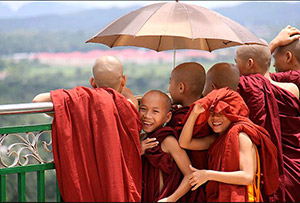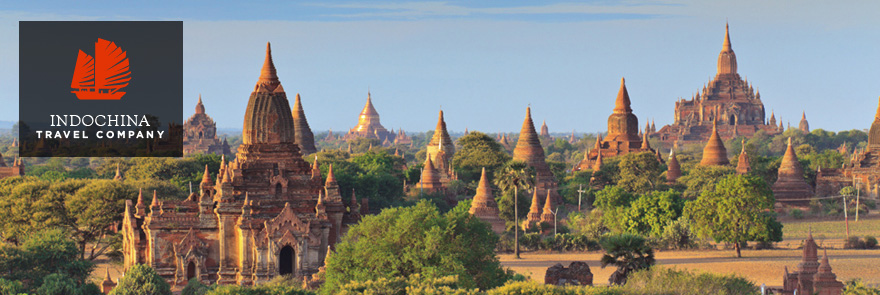
Myanmar, Land of Gold
Not much has changed since Orwell spent his time in what was then Burma, penning this passage in his classic Burmese Days, to the delight of travelers who have found almost every other destination in Asia transformed in recent decades Following the classic travel itinerary of the country, although with our unique take on the sequence of places visited, this trip, like our annual photography series, will focus on the exceptional landscapes and people-to-people encounters from a photographer's up close and intimate perspective. The Inle Lake basin offers a sublime setting, a visually intriguing landscape and where a diversity of colorful hilltribe cultures converge in the tranquil setting. Differing from popular destinations, Bagan and Mandalay, Inle features cooler mountain landscapes and a rich diversity of hilltribe villages. This trip will encompass popular highlights and far lesser known ones, along with private activities and sightseeing, while emphasizing customs, architecture, arts, cuisine, history, vanishing traditional lifestyles in the villages through personal encounters in areas where few other travelers venture. We will also explore the region's stunning diversity of landscapes, from karst river valleys, desert plains, high-mountain ranges. Professional English-speaking guides are top-tier university graduates and/or most-experienced and knowledgeable in their region or field. A tour manager based in Yangon will monitor your trip will also ensure your journey with us goes as smooth as possible. Accommodations feature the finest properties in deluxe or suite-class rooms, chosen for historical interest, character, amenities, location and/or staff and client favorites. Please view information on our annual photography tours in Vietnam below. ItineraryDecember 12 & 13Chicago to DohaDoha Arrival Procedures December 14Doha to Yangon
After arrival from Doha, clearing immigration* (visa authorization required*) and customs, meet escort in terminal and after introductions, transfer to hotel (about 45 minutes). Following check-in, balance of day relaxing after the long flight or enjoying refreshments and orientation with your guide before beginning sightseeing in the downtown area, strolling to nearby Bogyoke Market for lunch. In the afternoon, continued sightseeing in the former capital exploring colonial-era street, alleys, and religious sites. In the evening, dining at your hotel or one of the city's few international restaurants. *Visa-on-arrival authorization is required in advance of arrival (arranged by Indochina Travel). Please carry visa-authorization documentation with your passport, which may be required for boarding your Yangon flight. Proceed briskly to visa kiosk on the ground floor with one pre-filled application, attached photo, and US$35 cash (first-come, first-served). December 15Yangon"Then, a golden mystery up-heaved itself on the horizon, a beautiful winking wonder that blazed in the sun, of a shape that was neither Muslim dome nor Hindu temple-spire. It stood upon a green knoll, and below it were lines of warehouses, sheds, and mills. Under what new god, thought I, are we irrepressible English sitting now?." ~Rudyard Kipling At dawn, visiting with escort at Shwe Dagon Pagoda ("Great Dagon Pagoda" or "Golden Pagoda"), symbol of the country and most important religious monument, and at about 2,500 years old, one of the world's oldest. Here, well circumnavigate the stupa as monks arrive to chant and pray, and we'll enjoy meeting with some this first full day in Myanmar as introduction to the country's deep spirituality that permeates its culture. After Shwe Dagon, taking in breakfast at a nearby tea shop, sipping sweet milk tea and delicious finger foods before continued exploration of the city, visiting other notable religious monuments, including Sule Pagoda, the large golden stupa in the city center and focal point for the country's recent political protests; Chaukhtatkyi Pagoda, with it's famous colossal reclining Buddha; and the National Museum, rich with an abundance of artifacts and cultural exhibits of Myanmar, offering an interesting introduction to the country and its history; Botataung Pagoda a famous landmark of the capital on Rangoon's waterfront which retains many ancient, sacred relics.
Also visiting other notable religious monuments, including Sule Pagoda, the large golden stupa in the city center and focal point for the country's recent political protests, Chaukhtatkyi Pagoda, with it's famous colossal reclining Buddha; and the National Museum, rich with an abundance of artifacts and cultural exhibits of Myanmar, offering an interesting introduction to the country and its history, followed by exploration of Botataung Pagoda a famous landmark of the capital on Rangoon's waterfront which retains many ancient, sacred relics. Also meeting with monks to discuss their beliefs and lifestyle. By preference, visiting Aung San Suu Kyi's National League for Democracy office near downtown, talking with staffers and learning about their organization. In the evening, dining at one of Yangon's fine restaurants. Yangon's top options include Le Planteur, offering pleasant tropical garden dining, the 50th Street bistro for International fare in a pub setting, Coriander Leaf for Indian (near the Governors), and sophisticated Thai at Sabai Sabai. Other place in Yangon include the popular Padonmar, near to The Governor's Residence, has delicious Burmese dishes (try the butter fish curry with tomato paste). The Feel restaurant near the French Embassy has variety of local Burmese dishes and snacks and l'Opera, near Inya Lake hotel, has good Italian food. Asoka, near the Chatrium Hotel, has tasty Indian. Happy Noodle on Inya Street has variety of noodle dishes from across the country (this is a paradise for noodle lovers and busy with well-heeled locals). Tai Yin Thar at the corner of Parami and May Kha Street has variety of ethnic Myanmar dishes including grilled fish (Shan Style) and chicken curry (Kachin style)... yummy! For street food, we recommend 19th Street, an area which has a very lively atmosphere being very popular with locals, and where you can taste locally made draft beers. 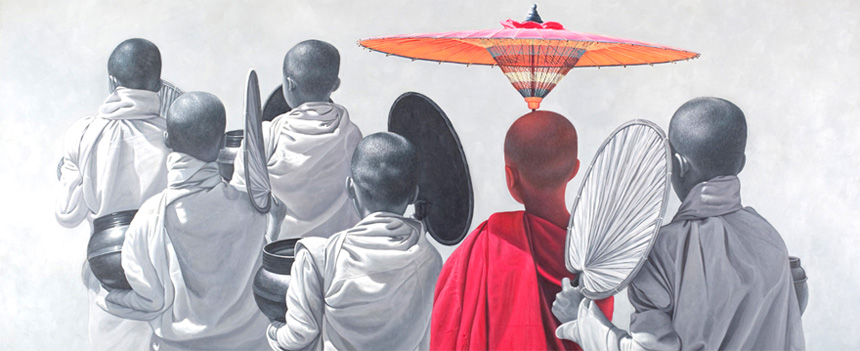
Yangon Art EncounterMuch as Vietnam's now-flourishing art scene was a decade ago, Burmese artists are scattered across the city typically working out of their homes and there are only a handful of galleries yet they are begin to be noticed. The River Valley, owned by New Zealander expat Gill Pattison is a obvious place to begin, centrally located in the Strand Annex, Ms. Patterson can also speak about here six years in Yangon and her experiences with the local artist community. An important stop in the community is a visit with Aung Myint in his Inya Gallery. Myint has exhibited since the 1960s and is considered a pioneer in experimental art, rejecting traditional romanticism and confronting social and critical issues through a range of distinctive styles and media. Aye Ko's New Zero Art Space features a wide range of Burmese artists and manages an artist-in-residence program, under which foreign artists visit and share ideas with Burmese art students. Non-traditional galleries and artist studios around the city to be visited by preference. December 16 & 17YangonDecember 18Yangon to Mandalay
After arrival in Mandalay, the historic former and still the spiritual capital of the country, transfer to central hotel (about one hour). Mandalay is where the strongest expression of traditional arts and crafts are centered, rich with historical sites, cultural memorials, and significant Buddhist monuments that reflect the strong current of Buddhism here which we will begin to explore after arrival. After refreshments and orientation, visiting notable temples and in the afternoon, enjoying a leisurely hike up Mandalay Hill which affords panoramic views over the old palace and distant plains and mountains. In the evening, sightseeing in central Mandalay before dinner. Although Mandalay is well known for its largely romantic literary fame from a colonial-era past, Rudyard Kipling never actually visited the city and Mandalay itself is largely newer construction; in the 1980s, the city was hit by two major fires that destroyed tens of thousands of buildings and much of the central area of the city are buildings erected since that time. Many of the recent inhabitants are also new, an estimated 300,000 ethnic Chinese have recently made the city their home. December 19Mandalay & Amarapura
Midday, return for lunch at one of the cities busy teashops serving delicious chapati, curries and milk tea. In the afternoon, visiting with graduate-level monks at the Pariyatti Sasana University of Buddhism. Here, we'll engage the monks and learn about their lives while they will be curious about ours, a fascinating encounter. After, sightseeing by preference. Other highlights include secondary temples, including Mahamuni Pagoda, Shwe Inbin Monastery, and Shwenandaw Monastery, noted for its exquisite wood carvings; Kuthodaw Pagoda, renowned for its stone slabs of the Buddhist scriptures, and arts and crafts shops, and galleries (Maharnadi), including highly-regarded gold-leaf producers and silversmiths. Mandalay is the country's spiritual capital and based in and around Mandalay, is a strict monastic "Sangha" of ordained Buddhist monks or nuns. The Sangha were originally established by Gautama Buddha in the 5th century BCE in order to provide a means for those who wish to practice the Dhamma full time, in a direct and highly disciplined way, free from the restrictions and responsibilities of everyday life. The Sangha also fulfills the function of preserving the Buddha's original teachings and of providing spiritual support for the Buddhist lay-community. The key feature of Buddhist monasticism is the adherence to the vinaya, which contains an elaborate set of rules of conduct including complete chastity and eating only before noon. Between midday and the next day, a strict life of scripture study, chanting, meditation, and occasional cleaning forms most of the Sangha's duties and transgression of rules carries penalties ranging from confession to permanent expulsion from the Sangha. December 20Minigun & Sagaing
After lunch, crossing over the Ayerwaddy River, pause to visit Sagaing, an important religious center (Buddha is said to have visited the hills of Sagaing), with dozens of historical stupas, Buddhist nunneries and monasteries, as well as an important monastic hospital and Sitagu Buddhist Academy, the university of a strict Sangha Buddhist order (read more below). Most notable here is the Kaunghmudaw Pagoda, a large whitewashed building whose name means 'work of great merit', and Tupayon Pagoda, known for its unique architectural style. In Sagaing also resides Mingun bell, the largest ringing bell in the world and Innwa Bridge, a British-engineered, 16-span bridge that dates to 1934 (it was the only bridge crossing the Irrawaddy River until 1998). In the afternoon, return to Mandalay for strolling the central sights until dinner.
Other organizations and institutions can be arranged by preference, such as health clinics, and monasteries, which fill a void in education for youth. Mandalay is the country's spiritual capital and based in and around Mandalay, is a strict monastic "Sangha" of ordained Buddhist monks or nuns. The Sangha were originally established by Gautama Buddha in the 5th century BCE in order to provide a means for those who wish to practice the Dhamma full time, in a direct and highly disciplined way, free from the restrictions and responsibilities of everyday life. The Sangha also fulfills the function of preserving the Buddha's original teachings and of providing spiritual support for the Buddhist lay-community. The key feature of Buddhist monasticism is the adherence to the vinaya, which contains an elaborate set of rules of conduct including complete chastity and eating only before noon. Between midday and the next day, a strict life of scripture study, chanting, meditation, and occasional cleaning forms most of the Sangha's duties and transgression of rules carries penalties ranging from confession to permanent expulsion from the Sangha. December 21Mandalay to Monywa
After departing Mandalay, crossing over the Ayerwaddy River, pause to visit Sagaing, an important religious center (Buddha is said to have visited the hills of Sagaing), with dozens of historical stupas, Buddhist nunneries and monasteries, as well as an important monastic hospital and Sitagu Buddhist Academy, the university of a strict Sangha Buddhist order (read more below). Most notable here is the Kaunghmudaw Pagoda, a large whitewashed building whose name means 'work of great merit', and Tupayon Pagoda, known for its unique architectural style. In Sagaing also resides Mingun bell, the largest ringing bell in the world and Innwa Bridge, a British-engineered, 16-span bridge that dates to 1934 (it was the only bridge crossing the Ayerwaddy River until 1998). Situated on the Chindwin River, this region is a major center of trade for agricultural produce and is known for it's quality weaving industry. There are several interesting sites to explore on the way to the provincial capital of Monywa including Thanboddhay Temple (left), a pagoda with hundreds of thousands of Buddha images and relics, Monywa's most famous sight. After arrival, strolling around town and visiting the busy local market, one of the largest in the area. Sangha is a strict monastic Sangha of ordained Buddhist monks or nuns. The Sangha of monks and the Sangha of nuns were originally established by Gautama Buddha in the 5th century BCE in order to provide a means for those who wish to practice the Dhamma full time, in a direct and highly disciplined way, free from the restrictions and responsibilities of the household life. The Sangha also fulfills the function of preserving the Buddha's original teachings and of providing spiritual support for the Buddhist lay-community. The key feature of Buddhist monasticism is the adherence to the vinaya which contains an elaborate set of rules of conduct including complete chastity and eating only before noon. Between midday and the next day, a strict life of scripture study, chanting, meditation, and occasional cleaning forms most of the Sangha's duties. Transgression of rules carries penalties ranging from confession to permanent expulsion from the Sangha. December 22Monywa to Bagan
Henri Yule, one of the first Westerners to see Bagan in 1855 wrote in his reflections: "The whole, as seen from the river, might pass for a scene in another planet, so fantastic and unearthly was the architecture." You will savor this same view coming onto the ruins. After arrival, transfer to hotel and as the day wanes exploration of Bupaya, a Pyu-style stupa which is located on the banks of the Ayerwaddy River. At dusk, enjoy refreshments at resort while the sun sets over the temple plain.
December 22Monywa to Mount Popa
After, we head to Mount Popa, a long-ago extinct volcanic vent is held sacred as home to Burmese animist spirits (nats). Upon arrival to the foothill of the mount, we'll begin hiking up the over seven hundred of steps to reach the summit of extinct volcano, exploring the temple at it's summit and taking in the stunning views of the area. We'll met and converse with resident monks about the history of Popa and a short rest. After exploring Popa, lunching at a pleasant restaurant with views over the area before returning to Popa. In the late afternoon, enjoying leisure time before we rendezvous for a pleasant cruise on the Irrawaddy before dinner. Note: wild monkeys are aggressive and may try trying snatch things in your hand away. In 442 BC, as legend has it, a great earthquake roared through central Myanmar and from out of the barren Myingyan plains arose Mount Popa. Volcanic ash gradually became fertile soil, and the peak blossomed with flowers of many colors. Indeed, Popa is the Sanskrit word for 'flower'. For the inhabitants of the surrounding region, the peak became known as the home of the gods, the 'Mount Olympus' of Myanmar. Alchemists and occultists made their home on the slopes, and people generally became convinced that mythical beings lived in its woods and flowers. The mountain, 1,518 meters high, is located about 50 km southeast of Bagan and it has recently become a national park. During the month of Nayon (May/June), the annual Festival of the Spirits is held here. On clear days, the view from the top across the vast dry plains is perhaps the most beautiful panorama to be seen anywhere in central Myanmar.
December 23Popa to BaganAfter witnessing a dramatic sunrise over plains, depart Popa for Bagan. Henri Yule, one of the first Westerners to see Bagan in 1855 wrote in his reflections: "The whole, as seen from the river, might pass for a scene in another planet, so fantastic and unearthly was the architecture." You will savor this same view coming onto the ruins, viewing hundreds of redden temples dotting the plain. After arrival at hotel to freshen up, visiting the Bagan viewing platform with panoramic views over the temple plain. After lunch on riverfront, exploring primary temples of the complex through the afternoon. As the day wanes exploration of Bupaya, a Pyu-style stupa which is located on the banks of the Ayerwaddy River. December 24B A G A N
Balance of day exploring Asia's equally renowned archaeological site along with the Khmer temples at Angkor, visiting several of Bagan's distinctive pagodas including Ananda Pagoda, one of the finest, largest and best-preserved in Old Bagan with a display ornate murals of 554 scenes from past lives of the Buddha, and next to it, Ananda Ok Kyaung, one of the few surviving brick monastery buildings from the Early Bagan period. Also visiting Thatbyinnyu, Sulamani, 11th-century Shwezigon Pagoda, and Wetkyi-in- Gubyaukgyi , a 13th century 'cave temple with interesting fine frescoes. Balance of day visiting primary or secondary temples by preference, including the distinctive Dhammayangyi Pahto, a massive, later period temple with the finest brickwork in Bagan. At dusk, by preference, enjoying a scenic boat ride on the river upstream before return to town and dinner at a local restaurant serving Western and Asian dishes. Note: today, we will also visit a local monastery, meeting with novice monks. By preference, we can also visit a local medical facility where locals come for treatment, meeting with staff. Tradition carried by the local chronicles, catalogs a long line of fifty-five kings ruled over the Myanmar kingdom during the span of twelve centuries. However, the monuments were erected mostly between the 11th and 13th centuries A.D., when Bagan was the seat of the Myanmar dynasty. During this period an estimate 4.500 temples were built of which just over 2,000 survive, spread over 40 square kilometers. Several of these monuments are still highly venerated by the population, and attract numerous pilgrims and devotees from all over the country, particularly at festival times. This authenticated history of the dynasty, supported by epigraphic evidence, begins with the reign of Anawrahta (1044-77 A.D.). In 1057 Anawrahta conquered Thaton, the capital of the Thaton Kingdom, which ruled present day Lower Burma between the 9th and 11th centuries, and brought back to his capital the Theravada scriptures, a large number of Buddhist monks, and artists and craftsmen of every description. From the Mon monks the Bagan people received their alphabet, religion and scriptures. It was from this momentous moment that there began the extraordinary architectural and artistic activity which, in a little more than two centuries, covered the city and its environs with thousands of splendid monuments of every shape and size. December 25Bagan to Kalaw
Kalaw, a former British hillstation, lies at nearly 4,300 feet altitude on the western edge of the Shan Plateau and the area is inhabited by a diversity of hilltribes. There are also Indian Muslims, Bamars (from which the name Burma derives) and Nepalis (the latter descended from Gurkhas who had retired from the British military) who live in the area. Interestingly enough, the British colonial and missionary heritage remains in that many locals still speak English. Kalaw features well-preserved colonial architecture, including the railway station, Catholic churches and Tudor-style villas with English rose gardens — an interesting contrast to the traditional Burmese villages that surround the town. There are also interesting Buddhist monuments, including the Hnee Phaya, an old and sacred pagoda featuring a Buddha made from woven strips of bamboo, and the Shweumin Pagoda, built inside a natural limestone cave (a number of Buddha images inside the cave that were commissioned by King Narapataesithu). The lush surrounding mountains provide expansive views of the area, with unique sights such as elephants working in the pine forests, sweeping tea and coffee plantations with hilltribe women plucking tea leaves from the low bushes. Following arrival, exploring the small town, with a unique, if not surreal, mix of churches such as Christ the King church and Tudor-style houses sitting among English rose gardens. Before dinner, a short hike to the top of the viewpoint overlooking town and the surrounding hills. December 26Kalaw to Inle Lake
In the afternoon, enjoying a pleasant initial cruise on the lake.
December 27 & 28Kalaw to Inle Lake
Each day, after savoring the views of the lake over breakfast, followed by cruising by private boat to visit various village visiting cottage industries, including one with women of the famous Padaung hill tribe, who wear heavy brass rings around their necks as jewelry. Here, local workshops also produce handmade textiles, traditional crafts, and boats, we'll pause to observe before visiting Indein, a village with hundreds of ruins scattered among the vegetation. Also exploring the Nan Pan "5-day market," on the day it is in the area and Indein, a village known for it's collection of 17th century pagodas, pausing for introductions and photos with a local family. Afterwards, visit the unique 'jumping cats' monastery, Phaungdaw U Pagoda, and cottage industries and hilltribe villages in the area. We recommend at least one dinner at the nearby Inle View Resort (across the lake from the Aureum) Interestingly, the Padaung are actually a Mongolian tribe who have been assimilated into the larger Karen ethnic group. The Padaung only number several thousand, but attract a lot of interest for their practice of neck stretching. The custom is more than just a rare and certainly strange expression of beauty — the number and value of the rings confers status and respect on the wearer's family. The process begins when girls or around five or six, then continues with successive ring being added every two years. Padaung women can wear up to 45 pounds of the heavy brass rings around their necks. The Palaung hilltribe (not the Padaung long necks), common in the Inle area, derive their income from tea. It is said that about five hundred years ago the King of Shan state demanded tribute from the Palaung, who being animist, tribal and living a subsistence life could offer nothing. The king gave them tea and taught them how to cultivate it and today it is their cash crop. In recent history, the area was ideal for growing poppies for opium cultivation, but almost all growers have converted to other specialty crops unique to the high-altitude area, such as mandarin oranges, bananas, and tea (local Tea shops are typically the center of life and social activity in any town and a good place to sample the local product) December 29Inle (Heho) to Yangon
Following hotel check-in, enjoying afternoon sightseeing in the capital, visiting artists and galleries, crafts shops and artisans whose work is only now becoming recognized outside the country. Also option to enjoy the historic "circle line," a British-era narrow gauge railroad that departs the historic central station and loops through the outskirts of the city providing an interesting glance of outlying neighborhoods and even markets set up on platforms (about 90 minutes to three hours). Our car will pick us up midway if you do not want to complete the full circuit.
December 30Yangon to Golden RockWe suggest a midday departure for Golden Rock to time your visit with sunset or early this morning, departing Yangon by road to Golden Rock (via Bago, 194 km or about 5 hours). In the late morning, arrive at Golden Rock "base camp" and from there transfer to the hiking point by local shuttle. From the hiking point, the trek is approximately 4 kilometers or about 1 hour to the top. Once at the pagoda, admire the spectacular view, which is particularly beautiful at sunrise or sunset. Overnight in Goldenrock. December 31Golden Rock to Mawlamyaing
Mawlamyaing is situated on the left bank of the Thanlwin River, before it empties into the sea, 28 miles past the town, and is bounded by hills on the east. The city slopes down to the west and its length fronting the river is much greater than it breadth. Being near the sea and at the confluence of four rivers, it enjoys an equitable climate which, combined with a fertile soil, has been advantageous for the cultivation of grain, variety of staple crops, and orchards. A considerable amount of teak, rice, rubber, and fruits such as durians, mangosteen, pineapple, rambutan, mango and cashew are produced here. Highlights of Mawlamyaing are Kyaikthanlan and Mahamuni pagodas (the former with wonderful views over the area), the Mon Cultural Museum, and Seindone Minbaya Kyaung, a wooden structure originally a residence where King Mindon's queen sought refuge. Later it became a monastery and named after the queen. . There are also several mosques and churches in the town. January 1MawlamyaingNew Year's Day. January 2Mawlamyaing to YangonToday, return to Yangon. January 3 & 6Yangon to U.S.A.In the late afternoon, return to airport (about one hour), and after farewells with guide, enter terminal for flight to Bangkok. After arrival in Bangkok International, proceed through transit immigration, retrieve baggage, and proceed to connecting flight gate. Bangkok Suvarnabhumi International Airport Arrival Procedures Doha Arrival Procedures Hen gap lai, see you again, and thank you for traveling with us! 
02/13/14 Follow @mountain_and_me |







